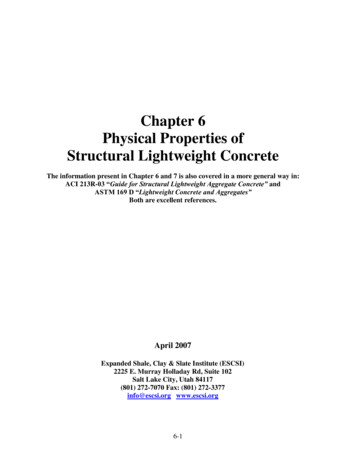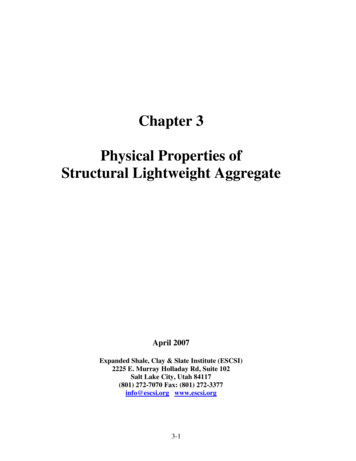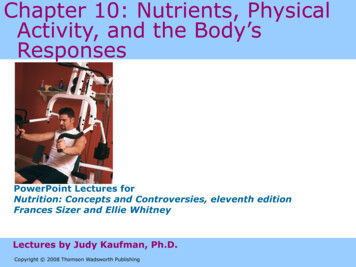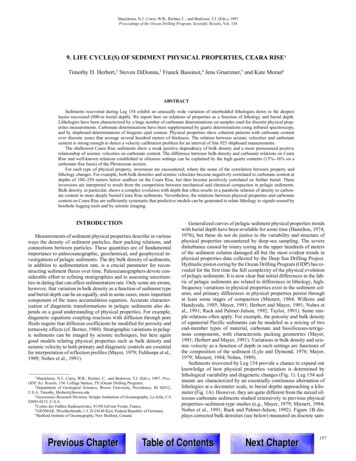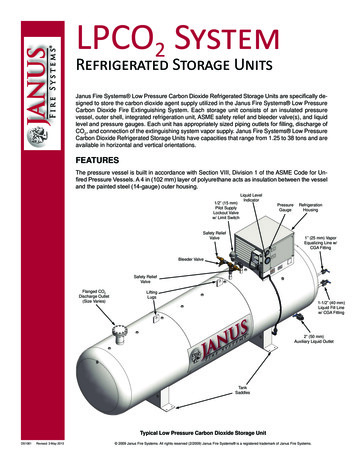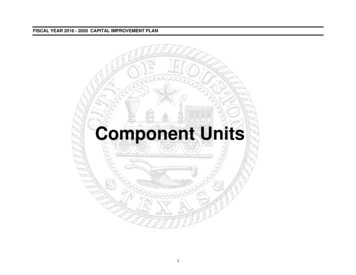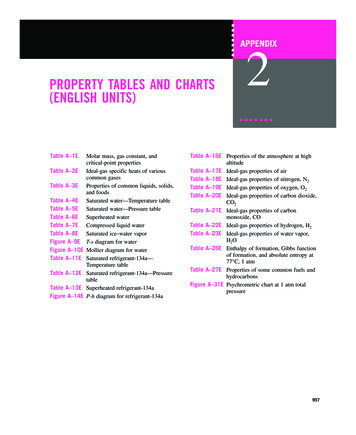
Transcription
Chapter 1Units, Physical Quantities andVectors1.1Nature of physicsMathematics. Math is the language we use to discuss science (physics,chemistry, biology, geology, engineering, etc.) Not all of the mathematicalideas were (so far ) applied to sciences, but it is quite remarkable to see howvery abstract mathematical concepts (one way or another) find their way intoscience. It was even conjectured (relatively recently) that may be all of themathematics has a physical realization somewhere. There are even evidencesfor that (i.e. multiverse theories), but it is perhaps too speculative to discusshere.Physics. Physics is built on top of mathematics and serves as a foundation for other sciences. Whether it bridges all of mathematics or only somebranches of mathematics we will never know. In fact one can never proveanything in physics. This should not be surprising given that even puremathematics suffers from incompleteness (Godel’s theorems). The best thatwe can do is to use the language of mathematics to construct physical theories to describe the world around us. The description might not be perfect,but it is remarkable how well we can do.So one can think of physics as a toolbox of ideas which can be used inbuilding scientific models in chemistry, biology, geology, astronomy, engineering, etc. Thus the more tools are in your toolbox the better scientist you willbe. In other words the more physics you know the better chemist, biologist,geologist, engineer you will be. But if you really like is to design new “tools”then you should think about becoming a physicist.1
CHAPTER 1. UNITS, PHYSICAL QUANTITIES AND VECTORS1.22Solving physics problemsConcepts. In most disciplines the more material you can memorized thebetter your final grade will be. This is not the case in physics. In fact it isnot the material that you have to learn, but the so-called physical conceptsand physical laws that you have to understand. (If you will decide to becomea physicists, then in few years you might learn that there is actually onlya single very deep concept, known as the least action principle, and almosteverything follows from it.) So the main issue in physics is to learn physicsconcepts (e.g. Newton laws, conservation of energy, momentum, etc.). Andlearning how to learn physics concepts will be your first and perhaps mostdifficult task. I will try to help you with that, but it will be a lot more efficientif you also help each other. Please discuss concepts, problems, solutions, etc.with each other.Problems. The only way to evaluate if you really understand conceptsis to solve problems. Understanding how someone else (e.g. classmates,professors, etc.) solves problems is good, but definitely not enough. Yes, youmight have hard time solving problems at first, but it is absolutely essentialto learn how to solve problems on your own. The book provides usefulstrategies and I encourage you to try to apply these strategies, but I amafraid only practice can make you an expert. For your own record keep trackof how many problems you solved by yourself in each chapter (without anyonehelping or googling answers). I bet this number will be strongly correlatedwith your grade on exams as well as your final grade.1.3Standards and UnitsUnits. Physics is an experimental science and experiments involves measurements of, for example, time, length, mass, etc. To express the resultsof measurements we use units. Units of length, units of time units of mass.There are some standard units just because historically we decided that theseunits (e.g. seconds, meters, kilograms) are convenient in physical experiments. Not everyone (e.g. American and British vs. European) agrees whatshould be the standard units and the history of such debates is quite interesting. One the other hand we should always be able to convert from onesystem of units to another given the “dictionary”.Time. What is time and arrow of time is a deep philosophical question.We might discuss it a bit in the last day of classes in context of the secondlaw of thermodynamics. At this point all the we have to remember that timeis measured in units of seconds, milliseconds, microseconds, nanoseconds and
CHAPTER 1. UNITS, PHYSICAL QUANTITIES AND VECTORS3here is the dictionary:1 nanosecond 1 ns 10 9 s1 microsecond 1 µs 10 6 s1 millisecond 1 ms 10 3 s.(1.1)Length. Despite of the fact that length and time appear to us verydifferently, there is a very deep connection (symmetry) between them. Wemight discuss is briefly when we discuss gravitation, but you might not understand it completely until you take a course in special relativity (PHYS2021). Meanwhile let just remember the conversion dictionary for units oflength1 nanometer1 micrometer1 millimeter1 centimeter1 kilometer 1 nm 10 9 m1 µm 10 6 m1 mm 10 3 m1 cm 10 2 m1 km 103 m.(1.2)Mass. Mass is also something very familiar to us in everyday life, butalso has very deep properties connecting it so length and time. We mightmention it briefly in connection to black-holes, but you would not appreciateuntil you take a course in general relativity (PHYS 5551) or a math coursein differential geometry. As far as the conversion of units goes we have thefollowing dictionary1 microgram 1 µg 10 6 g 10 9 kg1 milligram 1 mg 10 3 g 10 6 kg1 gram 1 g 10 3 kg.(1.3)Other units can be formed from seconds, meters and kilograms, for example,the unit of speedunits of volumeor units of forcemsm3kg · m Newton.s2
CHAPTER 1. UNITS, PHYSICAL QUANTITIES AND VECTORS1.44Converting UnitsDimension. Any physical quantity expressed in units of TIME, LENGTH orMASS is said to have dimensions of time, length or mass respectively. Moregenerally one can have physical quantities which have mixed dimensions. Forexample if d has units of LENGTH and t has units of TIME, then quantityd(1.4)thas units of LENGTH/TIME. Evidently Eq. (1.4) has quantities with thesame dimension (i.e. LENGTH/TIME) on both sides of the equation. So ifyou are given thatv d 30 mt 5s(1.5)then according to Eq. (1.4)v d30 mm 6 .t5ss(1.6)This must be true for any equation that you write. Checking that the quantities on both sides of equation have the same dimension is a quick, but veryimportant test that you could do whenever you setup a new equation. If thedimension is not the same than you are doing something wrong.Conversion. Sometimes you will need to convert from one system ofunits to another. This can always be done with the help of conversion dictionary. For the case of conversion from standard system of units to Britishsystem of units the dictionary is:1 in 2.54 cm1 pound 4.448221615260 Newtons(1.7)Then, if we are given a quantity in units of speed, then we can convert itfrom one system of units to another,36034 Ainin2.54 cm1h 360··hh1 in3600 sB 0.254cm.s(1.8)Note that although we have converted the units, the dimension of both sidesremains the same, i.e. LENGTH/TIME.
CHAPTER 1. UNITS, PHYSICAL QUANTITIES AND VECTORS1.55Uncertainty and Significant FiguresExperimental Measurements. Measurements are always uncertain, butit was always hoped that by designing a better and better experiment wecan improve the uncertainty without limits. It turned out not to be the case.There is a famous uncertainty principle of quantum mechanics, but you willonly learn it next year in (PHYS 2021) if you decide to take it. From ourpoint of view uncertainty is nothing but uncertainty in measurements. This(as well as significant figures) will be discussed in your lab course.1.6Estimates and Order of MagnitudeTheoretical Estimates. Similarly to uncertainties in experimental measurements, theoretical predictions are never exact. We always make simplifying assumption and thus the best we can hope for is an estimate forthe physical quantities to be measured. A useful tool in such estimatesis known as order-of-magnitude estimate (also know as outcome of “back-ofthe-envelope calculations”). Such estimates are often done using the so-calleddimensional analysis - i.e. just use the known quantities to form a quantitywith the dimension of the quantity that you are looking for.1.7Vectors and Vector AdditionVector. Some physical quantities are describe by a single real number. Wecall these quantities - scalar quantities or scalars. Examples are temperature,mass, density, etc.T 36.6 Cm 78 kggfl 1.05 3 .m(1.9)Other quantities also have a direction associated with them and thus aredescribe by three real numbers. (Ax , Ay , Az ).A(1.10)
CHAPTER 1. UNITS, PHYSICAL QUANTITIES AND VECTORS6We call these quantities - vector quantities or vectors. For example, position,velocity, acceleration, etc. r (1 m, 2 m, 3 m)m m m v (4 , 5 , 6 )sssm m m a (7 2 , 8 2 , 9 2 ).sss(1.11)There are even more complicated physical quantities - called tensor quantitiesor tensors - but we will not discuss them in this course. Apart from thenumber of real numbers which describe these physical quantities, the scalarsand vectors (and also tensors) change very differently under the change ofcoordinates.Graphical representation. When dealing with vectors it is often usefulto draw a picture. Here is how it is done: Vectors are nothing but straight arrows drawn from one point to another. Zero vector is just a vector of zero length - a point. Length of vectors is the magnitude of vectors. The longer the arrowthe bigger the magnitude. It is assumed that vectors can be parallel transported around. If you to end of another vector B then the vectorattach beginning of vector A A B is a straight arrow from begging of vector A to end of vector B.
CHAPTER 1. UNITS, PHYSICAL QUANTITIES AND VECTORS7Coordinates. The space around us does not have axis and labels, but wecan imagine that these x, y and z axis or the coordinate system to be there.This makes it possible to talk about position of, for example, point particlesusing their coordinates - real numbers. Since one needs three real numbersto specify position it is a vector. Similarly, velocity, acceleration and forceare all vectors.Symmetries. You might complain that there is arbitrariness in howone chooses coordinate system and you would be right. However, it turnsout that the physically observable quantities do not depend on the choice ofcoordinate systems and thus one can choose it to be whatever is more convenient. Moreover, this symmetry is an extremely deep property which givesrise to conservation laws that we will learn in this course. For example thearbitrariness of choosing the x, y and z coordinates gives rise to momentumconservation. And the arbitrariness in choosing time coordinate gives rise toEnergy conservation.
CHAPTER 1. UNITS, PHYSICAL QUANTITIES AND VECTORS1.88Components of VectorsMagnitude. The length of vector or magnitude is a scalar quantityor in components A A A(1.12)Ò(1.13)(Ax , Ay , Az ) For example the length of vectorA2x A2y A2z . (3, 4, 5)Ais A Ô32 42 52 Ô50 7.07106781187.(1.14)(1.15)Direction. One can also find direction of vector using trigonometricidentities. For example, in two dimensions (Ax , Ay , 0)A(1.16)the angle of the vector measure from x-axis is given bytan AyAyor arctan.AxAx(1.17)
CHAPTER 1. UNITS, PHYSICAL QUANTITIES AND VECTORS9Addition. Two vectors can be added together to get a new vector A B C(1.18)an in component form(Cx , Cy , Cz ) (Ax , Ay , Az ) (Bx , By , Bz ) (Ax Bx , Ay By , Az Bz ).(1.19)For example, the sum of two vectorsis (3, 4, 5)A (6, 7, 8)B(1.20)(3, 4, 5) (6, 7, 8) (9, 11, 13).(1.21)
CHAPTER 1. UNITS, PHYSICAL QUANTITIES AND VECTORS1.910Unit VectorsUnit vectors. Is a vector that has magnitude one. Its is usually denotedwith a “hat”:Ò û u2x u2y u2z 1.(1.22)For exampleor simplyÒÔÔ (1/ 2, 1/ 2, 0) 1/2 1/2 0 1ÒÔÔÔ (1/ 3, 1/ 3, 1/ 3) 1/3 1/3 1/3 1Ô (1, 0, 0) 12 02 02 1Ô (0, 1, 0) 02 12 02 1Ô (0, 0, 1) 02 02 12 1.(1.23)(1.24)In fact the last three vectors are so important that there are special lettersreserved to denote these vectorsî (1, 0, 0)ĵ (0, 1, 0)k̂ (0, 0, 1).(1.25)Multiplication / division by scalar. Any vector can be multiplied bya scalar to obtain another vector, C B. A(1.26)(Ax , Ay , Az ) C(Bx , By , Bz ) (CBx , CBy , CBz ).(1.27)In components from
CHAPTER 1. UNITS, PHYSICAL QUANTITIES AND VECTORS11Thus one can make a unit vector out of any vectorQR A(Ax , Ay , Az )AxAyAzb.Â Ò aÒ,Ò,Ò2222222222 A Ax Ay AzAx Ay AzAx Ay AzAx A2y A2zFor example if (2, 3, 4)Athen A(1.28)B222Ô ,Ô ,Ô.29 29 29(1.29)Components. Note that any vector can be written in components in twoequivalent ways: (Ax , Ay , Az ) Ax î Ay ĵ Az k̂A(1.30)Ax î Ay ĵ Az k̂ Ax (1, 0, 0) Ay (0, 1, 0) Az (0, 0, 1). (Ax , 0, 0) (0, Ay , 0) (0, 0, Az ) (Ax , Ay , Az )(1.31)just because1.10Product of vectorsScalar (or dot) product. Dot product is a multiplication between twovectors which produces a scalar: ·B B ·A CA(1.32)In components ·B (Ax , Ay , Az ) · (Bx , By , Bz ) Ax Bx Ay By Az Bz AB cos(„).A(1.33)
CHAPTER 1. UNITS, PHYSICAL QUANTITIES AND VECTORS12
CHAPTER 1. UNITS, PHYSICAL QUANTITIES AND VECTORS13One can also derive multiplication table for unit vectorsî · î (1, 0, 0) · (1, 0, 0) 1 0 0 1ĵ · ĵ (0, 1, 0) · (0, 1, 0) 0 1 0 1k̂ · k̂ (0, 0, 1) · (0, 0, 1) 0 0 1 1î · ĵ (1, 0, 0) · (0, 1, 0) 0 0 0 0ĵ · k̂ (0, 1, 0) · (0, 0, 1) 0 0 0 0k̂ · î (0, 0, 1) · (0, 0, 1) 0 0 0 0.(1.34)But then we can also apply the second component representation of vectors(given by Eq. (1.30)) to check that Eq. (1.33) is indeed correct ·B (Ax î Ay ĵ Az k̂) · (Bx î By ĵ Bz k̂) A Ax î · Bx î Ax î · By ĵ Ax î · Bz k̂ Ay ĵ · Bx î Ay ĵ · By ĵ Ay ĵ · Bz k̂ Az k̂ · Bx î Az k̂ · By ĵ Az k̂ · Bz k̂ Ax Bx Ay By Az Bz .(1.35)Vector (or cross) prod
Physics is an experimental science and experiments involves mea-surements of, for example, time, length, mass, etc. To express the results of measurements we use units. Units of length, units of time units of mass. There are some standard units just because historically we decided that these units (e.g. seconds, meters, kilograms) are convenient in physical experi- ments. Not everyone (e.g .




